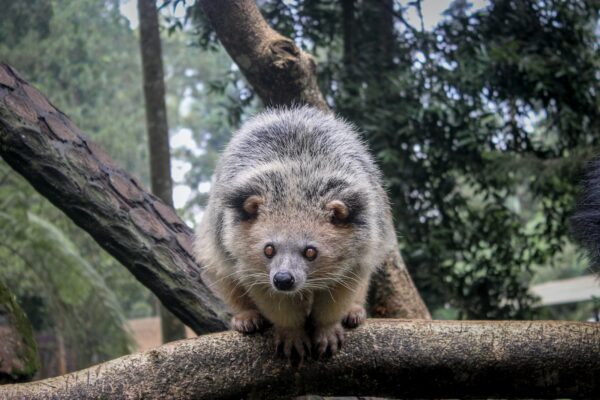Introduction
Known as the bearcat but not a bear or a cat, the Binturong (Arctictis Binturong) dances to its intriguing tune in the animal kingdom. This lesser-known creature has plenty to pique our curiosity, from its distinctive popcorn-like scent to its prehensile tail.
Physical Traits: Underneath the Binturong’s Fur
Size & Weight
Binturongs are robust, medium-sized animals. They range in length from 24 to 38 inches, with their powerful, muscular tails adding 22 to 33 inches. Regarding weight, females are typically heavier than males, with some tipping the scales at over 50 pounds.
Distinctive Features
Donning a thick, black, and coarse fur coat, the Binturong is well-equipped for its life in the trees. The skin on their faces is somewhat paler, sprinkled with long white whiskers. Their ears are tufted with white hair, adding a whimsical touch. One of the Binturong’s most remarkable features is its prehensile tail, which acts as a fifth limb for climbing.
Lifespan: Clock Ticking in the Trees
In the wild, Binturongs usually live for approximately 10-15 years. However, in a managed care environment, they have been known to reach an impressive age of over 20 years, with some records showing a few living into their mid-twenties.
Habitat: Home Among the Treetops
Preferring a life above the ground, Binturongs are found primarily in the dense tropical rainforests of Southeast Asia, spanning from India and Nepal to the Philippines and Indonesia.
Diet: Jungle Banquet
With a diet befitting an omnivore, Binturongs dine on an array of fruits, especially figs, leaves, birds, fish, and eggs. Interestingly, they’re one of the few animals that can digest the seeds of the strangler fig.
Reproduction: Bearcats in the Making
Binturong females are unique as they possess delayed implantation, allowing them to time the development of their embryos. Usually, they give birth to a litter of 1 to 6 young ones after a gestation period of roughly 84-92 days.
Conservation Status: A Fight for Survival
The IUCN lists the Binturong as “Vulnerable” due to habitat loss from deforestation, hunting for traditional medicine, and the pet trade. Conservation efforts are now more critical than ever to preserve these unique creatures.
Fun Facts: The Popcorn-Scented Mystique
Have they ever imagined an animal smelling like buttered popcorn? Well, meet the Binturong! Their scent glands emit an aroma eerily similar to popcorn. They also stand out as the only Old World mammal and one of only two carnivores with a prehensile tail.
Despite its relatively unknown status, the Binturong is undeniably fascinating. As we grow to appreciate its charm, let’s remember the need to protect these popcorn-scented acrobats of the treetops. After all, every life adds a unique rhythm to the symphony of nature.


